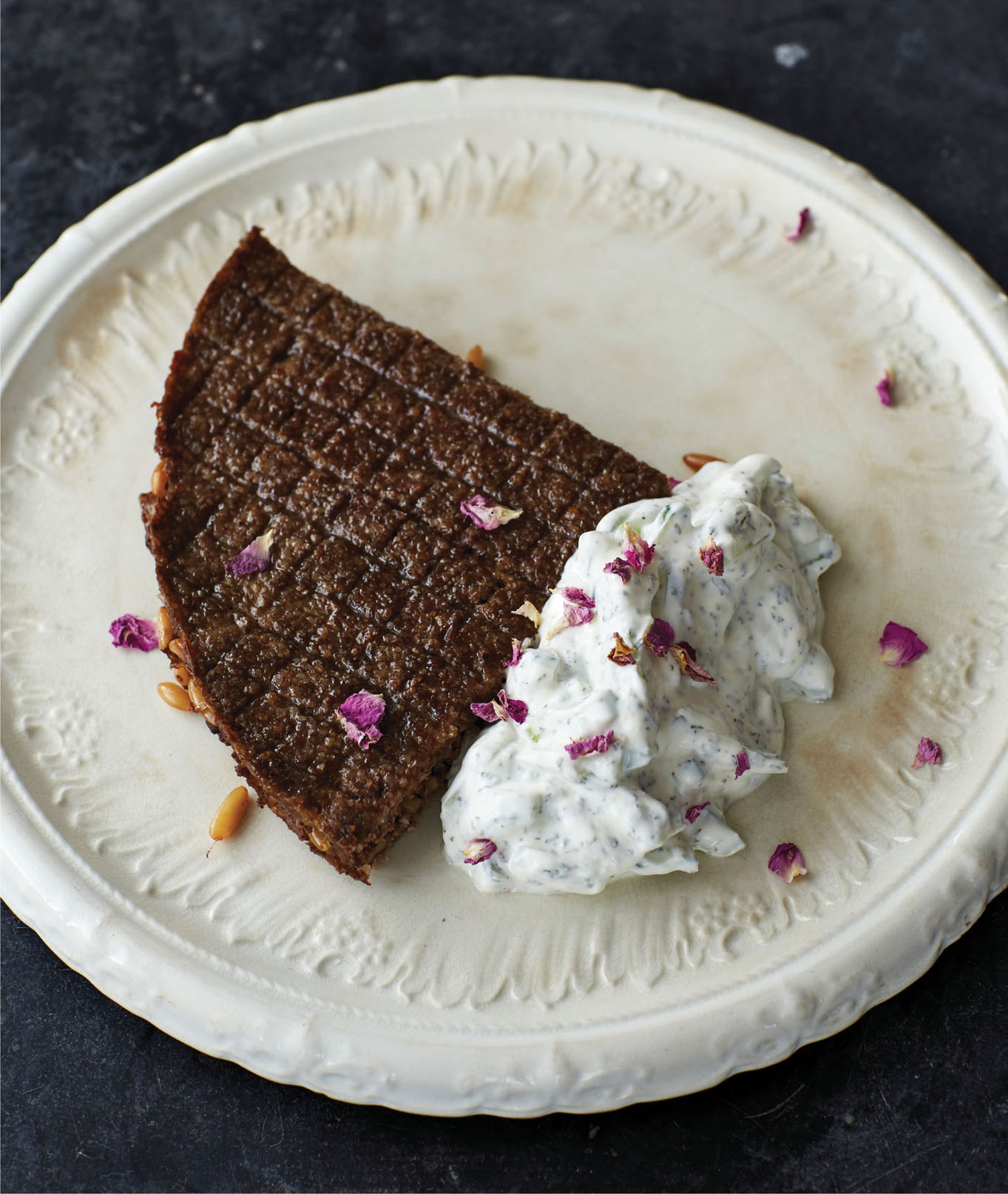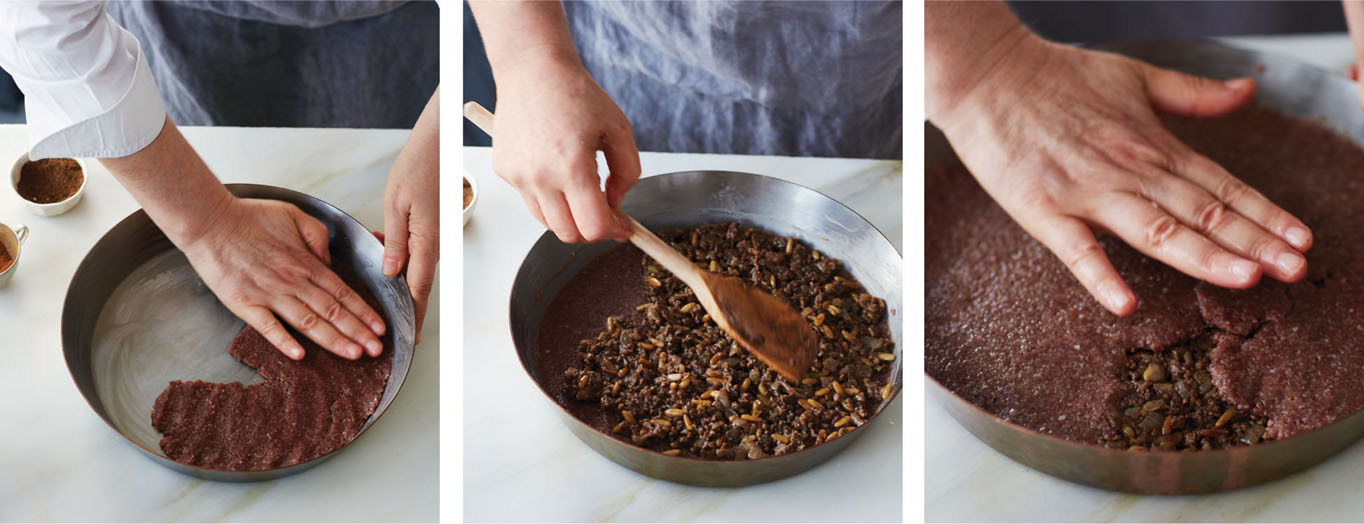KIBBEH BIL-SANIYEH
LEBANON | SYRIA

Kibbeh in Lebanon, Syria, Jordan, and Palestine, and kofte in Turkey, is a mixture of ground lamb and bulgur that can be shaped as a pie, balls, or disks and cooked in endless variations. The recipe below is for kibbeh bil-saniyeh, which is meat, onion, and nut stuffing spread in between two layers of kibbeh to make a pie. It is one of Lebanon’s grandest dishes, almost always present at special-occasion meals and big family reunions; and it is my go-to dish when I have friends coming over for a Lebanese meal. It is also one of the dishes that I like to demonstrate when I am teaching Lebanese cuisine. The last time I was teaching at Central Market, in Texas, together with Karen who runs the schools, we decided to do supper-club nights rather than straightforward cooking classes. We settled on a Lebanese menu with mezze to start, then kibbeh bil-saniyeh for the main course. I sent my recipes and arrived on the day to the usual warm welcome from everyone. But as I went through the ingredients for the dinner, I found they had purchased store-bought ground lamb for the kibbeh, which was far too fatty. So, when you make kibbeh, be sure not to buy preground meat! Ask your butcher to grind the lamb from the leg for you, or if you have a meat grinder, grind the meat yourself, after trimming it. Traditionally this kibbeh is made in a round baking dish, but my instructions are for a rectangular one as I am assuming that more cooks will have that shape than the more traditional round one. Sprinkle with rose petals and serve with the Yogurt and Cucumber Dip.
SERVES 6 TO 8
FOR THE STUFFING
Heaping ¼ cup (60 g) pine nuts
5 tablespoons (75 g) unsalted butter
1 pound (450 g) onions, finely chopped
7 ounces (200 g) lean ground lamb
2 teaspoons ground allspice
2 teaspoons ground cinnamon
½ teaspoon finely ground black pepper
Sea salt
1 teaspoon pomegranate molasses
FOR THE KIBBEH
1 small onion (3½ ounces/100 g), grated on the fine side of a grater
1 pound 2 ounces (500 g) boneless lamb leg, trimmed of fat and passed twice through the fine disk of a meat grinder
2 teaspoons ground allspice
2 teaspoons ground cinnamon
½ teaspoon Lebanese 7-Spice Mixture
½ teaspoon finely ground black pepper
Sea salt
1 cup (200 g) fine bulgur
6 to 8 teaspoons (30 g to 70 g) unsalted butter
1. Preheat the oven to 450°F (230°C).
2. To make the stuffing: Spread the pine nuts on a baking sheet and toast in the hot oven for 5 to 7 minutes, or until golden brown. Reduce the oven to 400°F (200°C).
3. Melt the butter in a deep skillet over medium heat. Add the onions and sauté until very soft and slightly caramelized, about 15 minutes. Stir in the lamb and cook, mashing and stirring with a wooden spoon or fork so that it separates well and does not form lumps, until it loses all traces of pink, 5 to 7 minutes. Take off the heat and season with the allspice, cinnamon, pepper, salt to taste, and pomegranate molasses. Stir in the toasted pine nuts. Taste and adjust the seasoning if necessary.
4. To prepare the kibbeh: Put the grated onion in a bowl. Add the ground lamb, spices, and salt to taste. Prepare a bowl of lightly salted water and have it at hand to use when you start mixing the meat with the bulgur.
5. Rinse the bulgur in two or three changes of cold water. Drain and add to the meat. Mix together with your hand, dipping your hand every now and then in the salted water to moisten both your hand and the kibbeh. Knead the mixture for 2 to 3 minutes, or until the mixture is fairly smooth. Taste and adjust the seasoning if necessary.
6. Grease a 2-inch (5 cm) deep baking dish about 12 x 9 inches (30 x 22.5 cm) with a knob of butter (or use a nonstick baking dish). Divide the kibbeh in half. Moisten your hands in the salted water and pinch off a handful of kibbeh from one piece. Flatten it between your palms, to a thickness of about ½ inch (1 cm), and place it on the bottom of the baking dish starting from one corner. Smooth it down evenly with your fingers, pinch off another handful from the same half, flatten and lay next to the first piece, slightly overlapping it. Dip your fingers in water and smooth the pieces together until the seam disappears—make sure you connect the kibbeh pieces well so they do not come apart during cooking. Continue until you have covered the bottom of the pan with the first half of kibbeh. Go over the whole layer with moistened fingers to even it out.
7. Spread the stuffing evenly over the bottom layer of kibbeh. With the other half of kibbeh, make a top layer over the stuffing in the same way as you made the bottom layer. Spreading the top layer over the stuffing will prove slightly more difficult as you will be laying the kibbeh over the loose stuffing instead of the smooth surface of the baking dish, but you will soon get the hang of it.
8. With a sharp knife, cut through the kibbeh pie to divide it into 6 squares, then with the same knife, wiped clean, make shallow incisions to draw a geometric pattern across the top of each section, wiping the knife clean every now and then to make a neat pattern. The decoration work is time-consuming and can be either omitted altogether or simplified into larger diamond patterns, but the presentation will not be as impressive. After you finish decorating the kibbeh, make a hole in the center of the kibbeh with your finger, and put a teaspoon of butter over the hole and one over each quarter. Insert a round-ended knife between the edge of the pie and the side of the pan and slide it all along the pie to detach the meat from the sides—you won’t need to do this if you use a nonstick pan.

9. Bake for 15 to 20 minutes, or until the kibbeh has shrunk slightly and the meat is just done. Let sit for a few minutes before cutting into squares. Transfer carefully to a serving dish. Serve hot or warm.